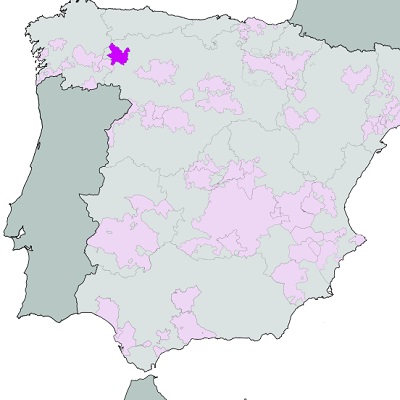Wine Region Castilla y León
Castilla y León is a large and diverse wine region, producing a range of red and white wines.

Castilla y León includes nine DO regions:
- (1982) DO Rueda
- (1982) DO Ribera del Duero
- (1987) DO Toro
- (1988) DO Bierzo
- (1991) DO Cigales
- (2007) DO Arlanza
- (2007) DO Arribes
- (2007) DO Tierra de León
- (2008) DO Tierra del Vino de Zamora

Rueda |

Ribera |

Toro |

Cigales |
Black Grapes | White Grapes |

65% Tempranillo |

|
Red Wines | White Wines |

|

|
Soil | Climate |
|
Hilly |

Hot Summers |
DO Arlanza

Arlanza DO is located to the north of Ribera del Duero. The DO takes its name from the river Arlanza which flows through it.
The first written evidence of wine production in this area comes from the 12th century, when the monastery of Santa María de Bujedo de Juarros purchased vineyards on the banks of the rivers Arlanza and Duero.
Principle Reds: Tempranillo. Cabernet Sauvignon. Petit Verdot. Merlot.
Principle Whites: Albillo. Viura.
Climate: Altitude: 800 - 1200 m
Soil: Sand and Gravel. Clays in deeper layers.
DO Arribes

Arribes, on the border with Portugal, is a reasonably obscure wine region. Its speciality is the esoteric Bruñal grape: low yielding and dark-skinned. Nonetheless, it can produce spicy and full-bodied Spanish wine.
Principle Reds: Juan García. Tempranillo. Bruñal. Rufete.
Principle Whites: Malvasía Castellana.
Soil: Granite-Slate.
DO Bierzo

Principle Reds: Mencía. Alicante Bouschet.
Principle Whites: Doña Blanca. Godillo. Palomini. Malvasia.
Soil: a mixture of fine elements, quartz and slate.
The Bierzo DOP has a special microclimate which is beneficial for viticulture. On the one hand it is similar to the climate of Galicia with regard to humidity and rainfall, and on the other it is also similar to the hot, dry climate of Castile. The low altitude also helps to prevent late frosts and means that the grape harvest is usually about one month earlier than in Castile. The average annual temperature is around 12°C, with the minimum in winter of 3.5°C and maximum in summer of 24°C. The average annual rainfall is just over 700 mm, and the vines receive about 2,200 hours of sunshine per year. (Wikipedia)
Do Tierra de León

The large expanse of vineyards south of León has seen dramatic improvements in quality lately. The dark-skinned grape Prieto Picudo is gaining a following for its aromatic, powerful reds.
Principle Reds: Prieto Picudo. Mencía.
Principle Whites: Verdejo. Albarín. Godello.
DO Tierra de Zamora

To the west of Toro are the vineyards of Tierra de Zamora – red grapes are the mainstay of production here. The best vineyard sites flank the Douro river, planted on deep, sandy soils. Old bush vines, as ever, yield the most exciting Tempranillo reds in Zamora.
Principle Reds: Tempranillo. Garnacha. Cabernet Sauvignon.
Principle Whites: Malvasía. Moscatel. Verdejo. Albillo. Palomino. Godello.